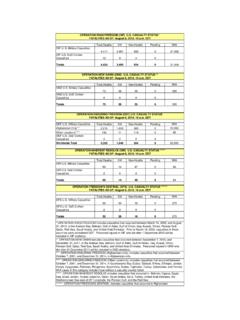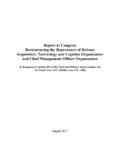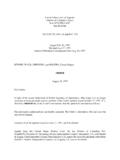Transcription of United States Assessment of the Assad Regime’s …
1 THE white house office of the Press secretary FOR IMMEDIATE RELEASE April 13, 2018 United States Assessment of the Assad Regime s Chemical Weapons Use Key Takeaway The United States assesses with confidence that the Syrian regime used chemical weapons in the eastern Damascus suburb of Duma on April 7, 2018, killing dozens of men, women, and children, and severely injuring hundreds more. This conclusion is based on descriptions of the attack in multiple media sources, the reported symptoms experienced by victims, videos and images showing two assessed barrel bombs from the attack, and reliable information indicating coordination between Syrian military officials before the attack. A significant body of information points to the regime using chlorine in its bombardment of Duma, while some additional information points to the regime also using the nerve agent sarin. This is not an isolated incident the Syrian regime has a clear history of using chemical weapons even after pledging that it had given up its chemical weapons program.
2 Chemical Weapons Use on April 7, 2018 A large body of information indicates that the Syrian regime used chemical weapons in the Duma area of East Ghutah, near Damascus, on April 7, 2018. Our information is consistent and corroborated by multiple sources. These chemical weapons were used as part of a weeks-long offensive against this densely populated opposition-held enclave. This assault has killed and wounded thousands of innocent civilians. On April 7, social media users, non-governmental organizations, and other open-source outlets reported a chemical weapons bombardment in Duma. Videos and images show the remnants of at least two chlorine barrel bombs from the attacks with features consistent with chlorine barrel bombs from past attacks. In addition, a large volume of high-resolution, reliable photos and video from Duma clearly documents victims suffering from asphyxiation and foaming at the mouth, with no visible signs of external wounds.
3 The World Health Organization (WHO) issued a statement about its concern over suspected chemical attacks in Syria, noting that victims showed symptoms consistent with exposure to toxic chemicals. Multiple government helicopters were observed over Duma on April 7, with witnesses specifically reporting a Mi-8 helicopter, known to have taken off from the Syrian regime s nearby Dumayr airfield, circling over Duma during the attack. Numerous eyewitnesses corroborate that barrel bombs were dropped from these helicopters, a tactic used to target civilians indiscriminately throughout the war. Photos of barrel bombs dropped in Duma closely match those used previously by the regime. These barrel bombs were likely used in the chemical attack. Reliable intelligence also indicates that Syrian military officials coordinated what appears to be the use of chlorine in Duma on April 7. Following these barrel bomb attacks, doctors and aid organizations on the ground in Duma reported the strong smell of chlorine and described symptoms consistent with exposure to sarin.
4 The symptoms described in reporting from media, non-governmental organizations (NGOs), and other open sources such as the WHO include miosis (constricted pupils), convulsions, and disruption to central nervous systems. These symptoms, in addition to the dozens of deaths and hundreds of injuries reported, suggest that the regime also used sarin in its attacks on April 7. The Assad regime chooses to deploy chemical weapons to terrorize and subdue both opposition fighters and the civilian population. It seeks to minimize regime casualties, in part because its military lacks the strength needed to otherwise prevail. Because the regime s intent is to terrorize, it makes no effort to discriminate between military and civilian targets. By using these banned weapons and wantonly bombarding civilian neighborhoods with conventional munitions and crude barrel bombs, Assad is collectively punishing his own people as a warning against further rebellion.
5 Further, Assad uses chemical weapons in a manner to maximize suffering, such as against families huddled in underground shelters, as was seen in Duma a population that was already negotiating for surrender and evacuation. The regime s continued use of chemical weapons threatens to desensitize the world to their use and proliferation, weaken prohibitions against their use, and increase the likelihood that additional States will acquire and use these weapons. To underscore this point, not only has Russia shielded the Assad regime from accountability for its chemical weapons use, but on March 4, 2018, Russia used a nerve agent in an attempted assassination in the United Kingdom, showing an uncommonly brazen disregard for the taboo against chemical weapons. In this case as with previous instances of regime chemical weapons use United States experts considered alternative explanations beyond the Syrian regime s culpability for chemical weapons use.
6 Within hours of the first allegation of chemical use on April 7, Syria s state-run news agency painted the reports as a smear campaign by the last remaining opposition group in East Ghouta, Jaysh al-Islam. We have no information to suggest that this group has ever used chemical weapons. Further, it is unlikely that the opposition could fabricate this volume of media reports on regime chemical weapons use. Such a widespread fabrication would require a highly organized and compartmented campaign to deceive multiple media outlets while evading our detection. The Syrian regime and Russia have also claimed that a terrorist group conducted the attacks or that the attacks were staged are not consistent with the existing body of credible information. The Syrian regime, conversely, has already been condemned by United Nations (UN) investigators for past and continued chemical weapons attacks. It is the only actor in Syria with both the motive and the means to deploy nerve agents.
7 The use of helicopters further implicates the regime; no non-state group has conducted air operations in the conflict. Precedent of Chemical Weapons Use and Retention of Assets The Assad regime continues to flout international agreements to which it has assented, even after Russia agreed to act as a guarantor of the regime s compliance and claimed that the Syrian chemical weapons program had been neutralized. The Syrian regime and Russia have also worked to undermine international inspection and accountability mechanisms. Assad used sarin in November 2017, as the UN entity for attributing chemical use in Syria expired, ensuring that no UN Security Council (UNSC)-authorized investigative body remained to determine blame for chemical attacks. Since that time, the regime has also used chlorine on multiple occasions. The assessments of these attacks are based on credible, public information showing victims with symptoms of nerve agent exposure, including pinpoint pupils, as well as munitions of a type that largely matches previously assessed regime chemical munitions.
8 The Syrian regime has repeatedly used chemical weapons to compensate for its lack of military manpower, to achieve battlefield goals, and to compel rebel surrender, especially when the regime believes critical infrastructure or territory in the core of the country to be at risk. The regime has also demonstrated a willingness to use chemical weapons against entrenched opposition forces to maintain offensive momentum when as it calculates this behavior will not be detected and punished. The Syrian regime s chemical weapons attacks on Duma were part of an effort to recapture the city in order to eliminate the final opposition pocket in East Ghutah capable of threatening the capital. The regime also seeks to punish Duma s civilian population, who have long resisted Assad s domination, as a deterrent to further rebellion. The regime took advantage of Russia s protection to use chemical weapons to advance its assault on Duma.
9 If not stopped, Syria has the ability to produce and use more chemical weapons. The Syrian military retains expertise from its traditional chemical weapons agent program to both use sarin and produce and deploy chlorine munitions. The United States also assesses the regime still has chemicals specifically, sarin and chlorine that it can use in future attacks and that the regime retains the expertise necessary to develop new weapons. The Syrian military also has a variety of chemical-capable munitions including grenades, aerial bombs, and improvised munitions that it can use with little to no warning. Last fall, the Organization for the Prohibition of Chemical Weapons (OPCW)-UN Joint Investigative Mechanism (JIM) determined Syria was responsible for the sarin attack on Khan Shaykhun in April 2017. This determination was based in part on sample analysis that linked signatures from the Khan Shaykhun attack to previous samples from the Syrian regime s sarin stockpile, making clear that Syria retained chemical weapons well past its promise that it had destroyed its stockpiles and eliminated its program.
10 Chlorine Use Only Weeks after Khan Shaykhun The most recent attack in Duma represents a continuation of the Syrian regime s pattern of chemical weapons use. Only weeks after the Syrian regime used sarin on Khan Shaykhun, it dropped chlorine barrel bombs as many as three times on opposition forces between April 29 and May 6, 2017, as regime forces attacked toward Al Lataminah, near Khan Shaykhun, where the Syrian regime used sarin in April 2017. The United States has indications of regime helicopters in the vicinity of the targets around this time, pictures of an unexploded chlorine barrel bomb consistent with munitions the regime has used in previous chemical attacks, and a video of chemicals being dispersed. This evidence is consistent with what the OPCW-UN JIM detailed in its fall 2016 reports assigning responsibility to the regime for chlorine attacks in 2014 and 2015. Since 2014, the regime has used chlorine in similar battlefronts to terrorize opponents and break their will to fight.












